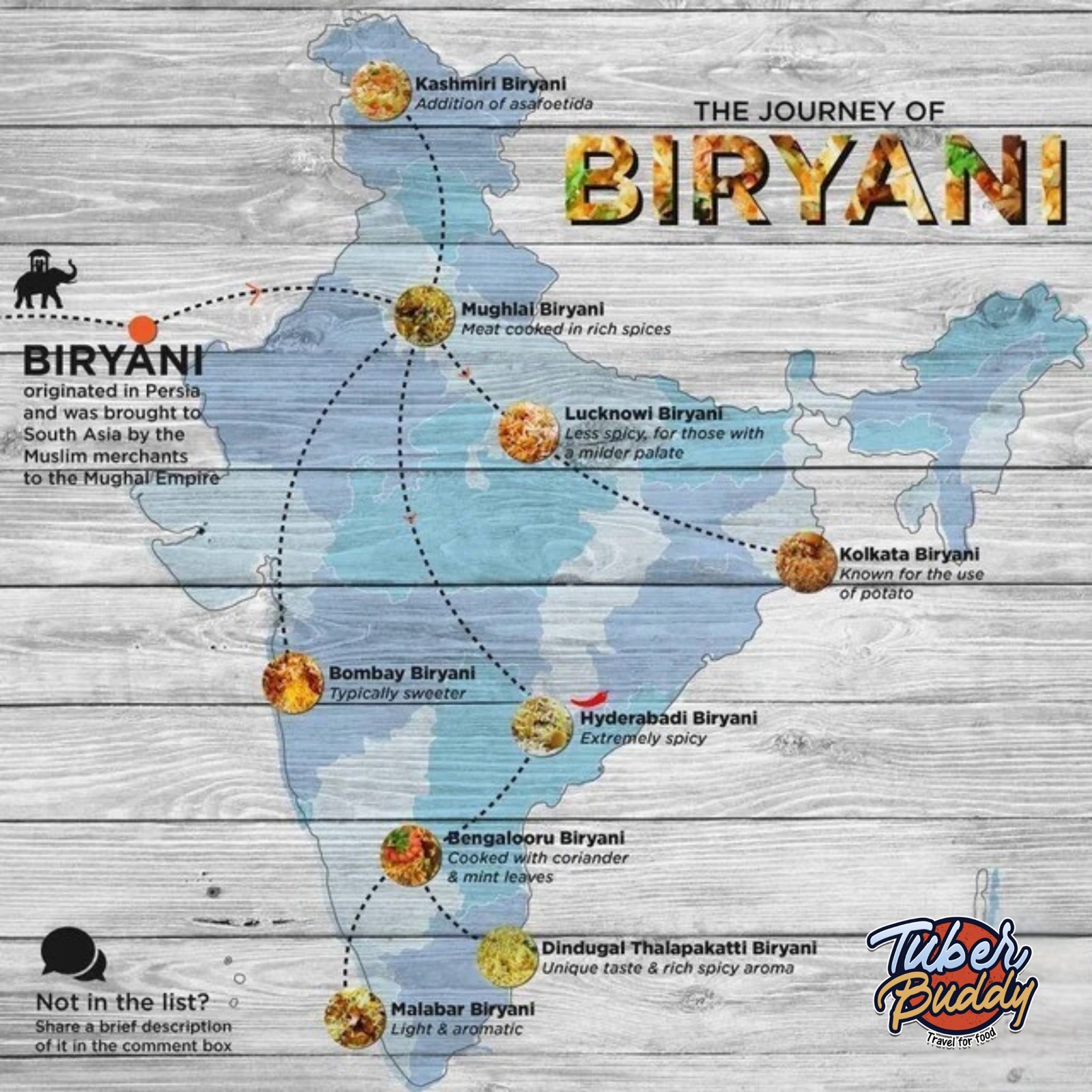From Persia to Plate: The Journey of Biryani Across Cultures and Continents

Biryani is more than just a dish—it’s a historical journey filled with flavors, aromas, and traditions that connect people across borders and generations. From its origins in Persia to its present-day forms across the Indian subcontinent and beyond, biryani has adapted and evolved, becoming a culinary icon that reflects a blend of cultures and local flavors. In this blog, we’ll explore how biryani traveled across continents, influenced diverse communities, and became a beloved dish around the world.
Origins of Biryani: The Persian Roots
The story of biryani begins in Persia (modern-day Iran), where a similar dish called “birinj” (meaning rice) was prepared by mixing rice with meat and spices. The Persian Empire was known for its opulent banquets, and lavish rice dishes like birinj became an integral part of Persian cuisine. When Persian emperors interacted with the Indian subcontinent during trade and conquests, they brought along not only their wealth but also their culinary practices, including birinj.
The Persian influence on the Mughal Empire in India played a crucial role in biryani’s journey. The Mughals, known for their love of luxurious feasts, embraced biryani and transformed it with local spices, ingredients, and techniques, giving birth to the biryani we recognize today.
Biryani Meets India: A Fusion of Cultures
When biryani arrived in India, it found itself in a land rich in spices, regional ingredients, and diverse cooking methods. Each region that embraced biryani left its unique mark on the dish, leading to the creation of multiple varieties that reflect local flavors and preferences. Today, biryani is a celebrated dish across India, with each region having its own signature style.
In Hyderabad, biryani is famous for its rich spices and slow-cooking method, while in Lucknow, the Awadhi biryani is known for its subtle flavors and dum pukht technique, where rice and meat are slow-cooked in a sealed pot to trap in the aromas. Tamil Nadu has the spicy Chettinad biryani, while Kerala’s Malabar biryani incorporates the unique flavors of coconut and curry leaves. These variations showcase the adaptability of biryani and its ability to absorb local flavors and traditions, creating regional versions that are celebrated across the country.
The Migration of Biryani: Reaching the Far East and Africa
As trade routes expanded, so did the reach of biryani. Traders, travelers, and immigrants took the dish with them, introducing it to new places and adapting it to suit local ingredients and preferences. In Southeast Asia, biryani has become a popular dish, particularly in Malaysia and Indonesia, where it’s often made with local spices and served with a twist.
In the African coastal areas of Kenya and Tanzania, biryani became a staple through the influence of Indian and Arab traders. The East African Swahili biryani has unique flavors, often incorporating coconut milk, local spices, and fresh herbs. This version highlights how biryani can adapt to local tastes while still maintaining its core essence—a blend of rice, meat, and aromatic spices.
The Rise of Biryani in the Middle East
In the Middle East, biryani was warmly welcomed, especially in countries like Saudi Arabia, UAE, and Kuwait, where it quickly became a favorite at social gatherings and celebrations. Biryani in the Middle East often features local spices like saffron and ingredients such as lamb and chicken, which align well with the local palate. Over time, this regional adaptation created Middle Eastern versions of biryani that are distinct yet remain faithful to the original concept of the dish.
The Gulf countries, with their large South Asian populations, serve biryani at almost every restaurant. It’s common to find both traditional South Asian biryani styles and Middle Eastern adaptations in places like Dubai and Abu Dhabi, where the dish bridges communities and cultures.
Biryani’s Journey to Europe and the Americas
The global popularity of biryani reached Europe and the Americas largely through South Asian immigrants, who brought the dish to these regions. As Indian restaurants gained popularity in cities like London, New York, and Toronto, biryani became a staple on the menus, often with new variations to suit the local population.
In the West, biryani has also seen fusion variations, with vegetarian options, seafood biryanis, and adaptations for health-conscious diners who seek lower-fat or gluten-free versions. This flexibility has allowed biryani to gain a broad appeal, becoming a favorite dish even among those unfamiliar with traditional Indian cuisine.

Different Styles of Biryani: A World of Flavor
Today, there are countless biryani styles, each representing the influence of local culture, ingredients, and preferences. Some of the most popular types of biryani include:
Hyderabadi Biryani – Known for its rich spices and the dum cooking method, this style is beloved for its layered flavors and use of saffron.
Lucknowi Biryani – Also known as Awadhi biryani, this version has a lighter, more delicate flavor profile, with an emphasis on aromatics and a softer texture.
Malabar Biryani – A unique variety from Kerala, often cooked with short-grain rice and infused with coconut and curry leaves.
Kolkata Biryani – This Bengali-style biryani includes potatoes, boiled eggs, and fragrant spices, resulting in a lighter, sweeter flavor.
Memoni and Sindhi Biryani – Found in Pakistan, these varieties are known for their bold use of spices, chilies, and rich flavors, making them highly aromatic and flavorful.
Each variety of biryani offers a different experience, showcasing the diversity within the dish and the ability of biryani to adapt to different regions while maintaining its core components.
The Modern-Day Popularity of Biryani
In today’s fast-paced world, biryani has not lost its appeal; in fact, it has only grown in popularity. With the rise of food delivery apps, biryani is one of the most ordered dishes in countries like India and the UAE. The popularity of biryani across online platforms and social media reflects its continued relevance and the emotional connection people have with the dish. Biryani is more than just food—it’s a cultural experience that brings people together, whether it’s shared at home with family, at celebrations, or with friends.
Conclusion: A Dish That Transcends Borders
Biryani’s journey from Persia to plate is a testament to the power of food to transcend borders, languages, and cultures. This dish, with its rich history and countless variations, has evolved to become a universal comfort food enjoyed by millions worldwide. Biryani is a reminder of the interconnectedness of different cultures and the shared love for food that brings us all together.
Today, whether you enjoy a traditional Hyderabadi biryani, a coconut-infused Malabar biryani, or a Swahili-style biryani on the coast of East Africa, each bite tells a story of tradition, adaptation, and the journey of flavors across continents. The journey of biryani from Persia to our plates celebrates the beauty of cultural exchange and the timeless appeal of delicious food.
Top 10 Restaurants in Chennai | Best Food Spots You Must Try Chennai, a bustling metropolis in Tamil Nadu, is a melting pot of cultures and cuisines. From traditional South Indian fare to international delicacies, the city boasts a plethora of dining options. Here’s a list of the top Top 10 Restaurants in Chennai that […]
Famous Food in Tamil Nadu | Traditional Dishes You Must Try Tamil Nadu, a state in southern India, is known for its rich culinary heritage and diverse flavors. From spicy curries to aromatic rice dishes and mouth-watering snacks, Tamil Nadu’s cuisine is a feast for the senses. Here are some of the top and Easy […]



